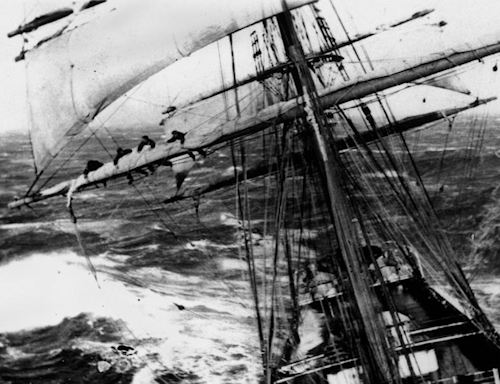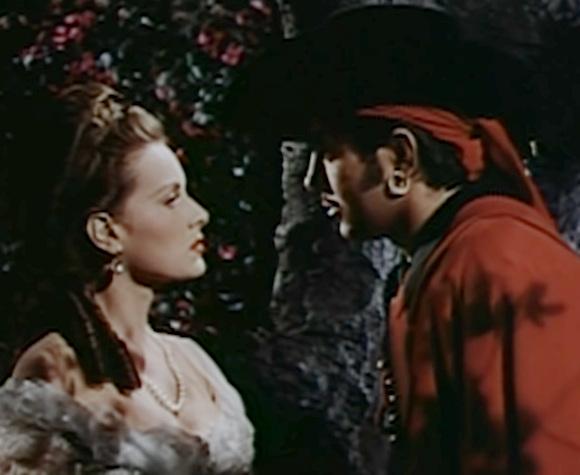Reading various texts and consulting the web, it happens to come across the most varied theories as to why sailors wore earrings in the past.
According to the customs of the old navy, for any pirate, the earring, together with the bandage and the bandana, was a fundamental 'accessory' because it was believed to bring good luck and protect him from drowning as well as… keep away scurvy.
The use of the earring by sailors spread in England in the second half of the 500th century when, through the routes to Asia, European sailors became acquainted with practices such as 'body piercing' and acupuncture (with the relative maps of pressure points).
Through these multi-ethnic contacts these travellers, not always of great culture, assimilated knowledge of other peoples, often without understanding its value. However, it was in this way that new customs but also oriental and African superstitions spread across the old continent.
The earring (in gold) represented their treasure
If they had died at sea and thrown overboard, the sailors would have found peace in the afterlife only if their bodies were then buried on land. The earring therefore represented the reward for those who, having found their corpse returned from the sea, then took care of their burial. Some even engraved the name of their hometown (as is used in military dog tags) to ensure that they could be buried at home. Others, to ensure a proper burial, wore coins in their belts.
One of the many superstitions was not to whistle on board (as it inspires storms), to have a tattoo (for who knows why good luck) or to throw a pair of shoes overboard immediately after launching a boat.
Beyond the superstition it was thought that the ear hole could improve vision, essential at sea to identify dangerous rocks and enemy vessels. A curious thing if you think that today's acupuncturists use pressure points on the earlobes precisely for the treatment of vision problems. A knowledge perhaps learned on long trips overseas?
Sea Wolves
 According to some versions, sailors wore only one gold earring, while according to others, they wore more than one in memory of important voyages, such as crossing the Equator or rounding Cape Horn. In the latter case, if the passage had taken place from West to East, the left ear was pierced (the one facing the Cape), while the right was pierced for the passage from East to West (much more difficult against winds and currents predominant).
According to some versions, sailors wore only one gold earring, while according to others, they wore more than one in memory of important voyages, such as crossing the Equator or rounding Cape Horn. In the latter case, if the passage had taken place from West to East, the left ear was pierced (the one facing the Cape), while the right was pierced for the passage from East to West (much more difficult against winds and currents predominant).
The maximum number of earrings was four, two per lobe, and they were worn after having rounded each of the following four geographical Heads:
- Cape Horn (South America)
- Cape of Good Hope (South Africa)
- Cape Finisterre (northern Spain)
- Cape Leuween (Australia).
In other words, the more earrings you wore, the more you proved to be a "Sea Wolf", so as to instill fear and obtain respect from your subordinates... as well as to give yourself a cunning air.
It also reads that "the homosexual sailors declared their willingness to report to the rest of the crew with the earring worn on the right lobe". But there are many doubts about this.
The alleged homosexuality of the sailors has often been embroidered. In an article published on British Tars, the author Kyle Dalton argues that, at least in the Anglo-Saxon context, it is yet another fake news, that is, the news reported on the texts of the time do not warm up the thesis of a vast homosexuality among the sailors.
In this regard, Rodger argued in his book The Wooden World: An Anatomy of the Georgian Navy that acts of homosexuality were not as common in the mid-XNUMXth century as many assume, pointing out that “There appear to have been only eleven tribunals martial for sodomy during the (Seven Years) War, of which four resulted in acquittals, and seven convictions on lesser charges of indecency or impurity”. This does not seem an extraordinarily large figure for a seafaring population numbering seventy to eighty thousand sailors at the time.
It should be specified that the term "homosexual" should refer to inclinations and acts, rather than defining the sailors themselves.
According to rumors born around the Royal Navy, the lack of access to women gave rise to homosexuality, as in the eighteenth century life on board, exclusively male, could make one think of wanting to settle in this sense. In reality, even the slightest suspicion was severely punished, even with death.
 The articles of the Royal Navy's Code of War of 1749 were very clear on the matter and gave no room for leniency: “Punishment for those who commit sodomy. XXIX. If a person of the Starfleet commits the unnatural and detestable Sin of Sodomy (Buggery) with Man or Beast, he shall be punished by Death with the sentence of a Court Martial."
The articles of the Royal Navy's Code of War of 1749 were very clear on the matter and gave no room for leniency: “Punishment for those who commit sodomy. XXIX. If a person of the Starfleet commits the unnatural and detestable Sin of Sodomy (Buggery) with Man or Beast, he shall be punished by Death with the sentence of a Court Martial."
In a famous XNUMXth century erotic novel, John Cleland's Fanny Hill, or Memoirs of a Lady of Pleasure, an explicit scene is described between the merry prostitute Fanny and a sailor. Fanny accepts the sailor's offer to join in a tavern, and there they do the deed “with an impetuousness and desire, most likely bred by a long fast at sea”. Cleland (let's not forget that it was an erotic libretto) describes the various pleasantries, underlining them with colorful naval metaphors. At one point, Fanny recounts: “He fell right on board me” and when “he wasn't going to the right door, and knocking desperately on the wrong one, I told him of it: 'Pooh!', and he replied 'my dear, any port in a storm”. The story is satirical and draws on the popular impression that sailors engaged in homosexuality on long voyages. In reality there is no evidence that it was practiced on board more than ashore. And the sailor's earring proudly worn by sailors was just a boast for having sailed so many seas.
Whatever the truth, sailors' earrings were always in the shape of a ring to finally testify to their marriage to the sea!
Images: (opening) still from the film "The Black Swan" (1942) / web
(article originally published on https://www.ocean4future.org)












